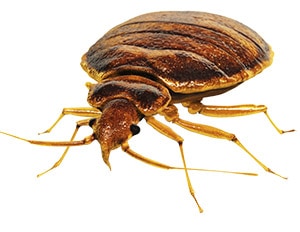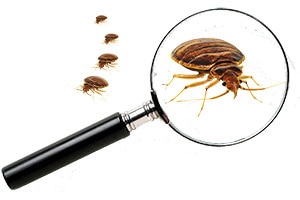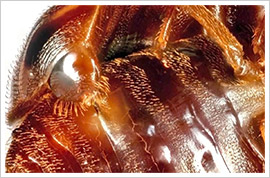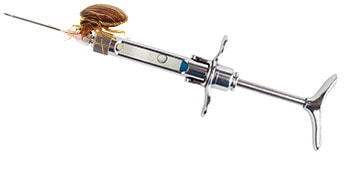
The estimated growth of bed bugs is between 100% and a whopping 500% annually. The proliferation of these parasitic insects can be attributed to multiple factors. An important one is the ban on insecticides like DDT, which were used extensively to eliminate hoards of bed bugs more than forty year ago, and had contained infestation to a large extent. However, pesticide resistance is an inevitable consequence when any product is overused, and the unfortunate fact is that bed bugs are now resistant to most pesticides. So much for the hard facts; let’s look at some unusual, lesser-known facts about bed bugs.
#1 : Bed bugs are elusive insects

Equipped with strong survival instincts, bed bugs are elusive. During daytime, they hide from view under box springs, in mattress crevices and behind picture frames. They are attracted to the carbon dioxide we release when we breathe, as well as warm and humid places. They are stealthy in their approach, a reason why you may not even feel them creeping upon you!
#2 : Bed bugs get comfortable just about anywhere

Bed bugs can set up home just about anywhere, from lavish, well-kept mansions to dirty hotel rooms. They have been found in single-family homes, apartments, multi-million dollar mansions, college dorms, hospitals, office buildings, movie theaters, retail stores and more. The perfect environment for these creatures is a dark, soft area with loads of hiding places and a consistent supply of blood meals. So your computer chair and sofas are not off-limits, and neither are your electrical sockets, baseboards, lighting fixtures, night tables, loose wallpaper and floor crevices. Bathrooms and kitchens are not immune to bugs. They, however, most commonly nest in bed parts such as box springs, mattresses and folded areas. This gives them quick access to their human meal.
#3 : Bed bugs don’t have to eat all the time

Bed bugs can survive for many months without a blood meal. In fact, they can go even up to a year without feeding, which means they’ll continue living in your furniture, suitcases and bags for a long time before they can get near a human host again. So if you were planning to leave your home for a few weeks in an effort to starve those bed bugs, think again! The only sire way to eliminate your bed bug problem is to call a professional bed bug exterminator like Bed Bug Exterminator Pro, or www.pestend.ca.
#4 : Bed bugs are as tough as they come

Bed bugs, like cockroaches, have learned to adapt to tough environments. While infestations are more common in summers, they can make it through the winter months as they stay indoors most of the time. Bed bugs can endure freezing temperatures and survive temperatures as high as 44 degrees Celsius. They can also flourish in dry or damp environments making them a problem all over the world. Bed Bug infestations are common in Canada from Vancouver to Toronto and beyond.
# 5 : Bed bugs cannot fly

Bed bugs are wingless insects, and hence cannot fly. They cannot hop or jump either. They just walk and walk, making their way from your mattress to your clothing and onto your couch and into your guests’ bags. They can travel the globe in suitcases and relocate in different directions to each of your colleagues’ homes from their nesting ground in your office pantry or supply room. This makes them formidable creatures because you’ll find it really difficult to spot bed bugs in motion if they don’t fly or jump!
#6 : Bed bugs mate prodigiously

The female bed bug lays roughly 500 bed bug eggs in her lifetime, which adds up to between one and five eggs a day! In an ideal environment, bed bugs can foster up to four generations of families in a single year! As small as poppy seeds, the eggs can be virtually impossible to spot, and in the majority of cases are not visible to the naked eye. The larvae of a bed bug can be smaller than a rice grain. If you suspect an infestation and have exceptionally keen eyesight, you may be able to spot bed bug eggs in the cracks and crevices of your bed or floor but you will most likely miss them. This is why many bed bug exterminators use dogs to sniff out bed bugs, because even experienced bed bug exterminators cannot always see these little blood suckers and their eggs, even though they know exactly where to look.
Females lay the eggs after a blood meal, and they hatch into nymphs after a week or two. The nymphs start feeding immediately, and the nymphal period lasts anywhere between 14 and 30 days.
#7 : Mating is traumatic for the female bug

Bed bugs mate rather violently in a process known as traumatic insemination. The male pierces the female’s abdomen with his genitalia and injects his sperm through a wound in her abdominal cavity. The sperm then starts its onward journey through her abdominal fluid till it reaches her ovaries. The wound increases chances of infection and disease in the female. As a result, her lifespan is reduced after mating. Naturally, the female may avoid mating again and get away from her nesting place to some other shelter. It is quite possible that the bed bugs hitchhiking along in your luggage, pocketbook or backpack may be a pregnant female looking for refuge from abusive male bed bugs.
#8 : Bed bugs are linked to social stigma

Social stigma is one of the side-effects of a bed bug infestation. People bitten by bed bugs are very likely to exhibit stress and anxiety over concerns that they may spread the infestation. The feelings associated with such a stigma also include despair, depression and insomnia. To make matters worse, people who have been repeatedly bitten by bed bugs can develop many reddish welts or raised bumps, and often struggle to enjoy restful sleep. As the bed bug count multiplies, the chances of getting bitten also increase and the sleep problem can intensify.
#9 : Bed bugs are not just night crawlers

Good night, sleep tight, don’t let the bugs bite. Catchy but not accurate. Here are the facts: Bed bugs are more active in the night, but they can bite at any time. Bed bugs are partial to stationary hosts who are fast asleep. But when they’re hungry, they don’t really care for the time of the day or the state of rest or motion of the prey. There’s no stopping them when they’re looking to make a quick meal out of you. Even if you’re wide awake enjoying an afternoon movie on your bed-bug infested couch, you may be bitten by hungry bed bugs.
#10 : The saliva of bed bugs acts like an anesthetic

When a bed bug bites you, it injects its saliva into the feeding spot. The saliva has both anesthetic and anti-clotting properties. That means you don’t feel the pain from the bite. Also, the anti-clotting agent promotes increased blood flow, making the feeding process quick and painless.


